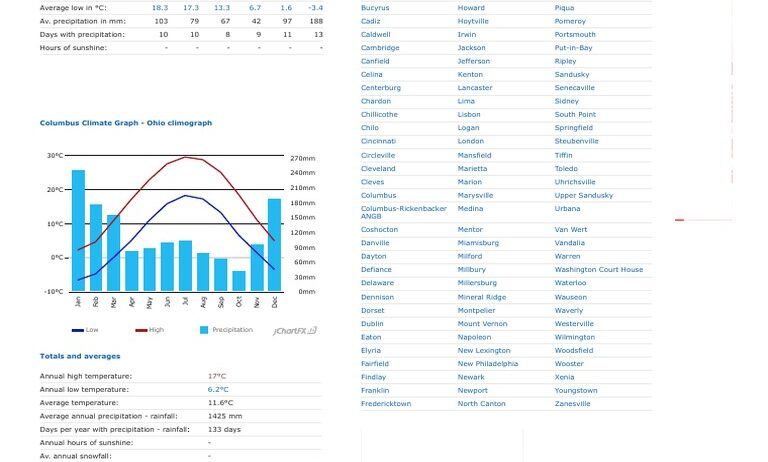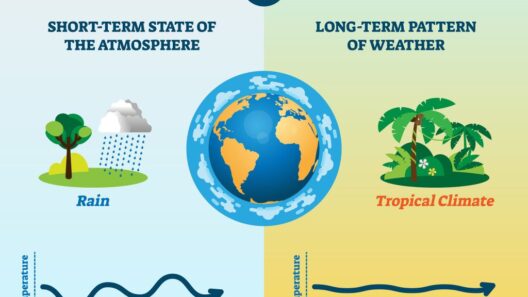Ohio, located in the heart of the Midwest, is characterized by a unique climate that manifests a mosaic of weather patterns throughout the year. The state experiences a humid continental climate, which leads to significant variations in temperature and precipitation. Understanding the climatic nuances of Ohio is essential not merely for residents but also for policymakers, businesses, and environmentalists. This article will delve into Ohio’s climate, dissect its components, and explore the implications of these climatic conditions.
To begin with, Ohio’s climate is significantly shaped by its geographic location. It is influenced by the Great Lakes to the north and the Ohio River to the south, which together create a distinctive hydrological effect. The state is sandwiched between warm air masses from the south and cold air masses from the north, resulting in a dynamic interaction that dictates weather patterns.
Ohio experiences four distinct seasons—spring, summer, autumn, and winter. Each season presents its own set of characteristics and challenges.
Spring in Ohio typically erupts with a kaleidoscope of colors as flora begins to blossom. Average temperatures in March and April hover around 50°F to 70°F. This transitional period often witnesses a tug-of-war between lingering winter coolness and the impending warmth of summer. Rainfall is common, and thunderstorms often punctuate the season, owing to the moisture-laden air colliding with warmer temperatures. Such violent weather can lead to severe weather events, including tornadoes, particularly in the southeastern part of the state.
Summer crowns Ohio with warmth, as average temperatures soar, often reaching the unpleasant peaks of 80°F to 90°F. This sultry season is marked by humidity levels that can be stifling, particularly in urban areas. The summer months are notable for their considerable precipitation, which tends to arrive in the form of thunderstorms and occasional severe weather events. The atmospheric conditions during this time may also spawn flash floods, necessitating community preparedness and infrastructural resilience.
As summer wanes, autumn emerges with its breathtaking transformation of landscapes. Average temperatures begin to dip, ultimately settling around 50°F to 70°F. The foliage becomes a canvas of fiery oranges, rich reds, and vibrant yellows, attracting tourists who seek to revel in Ohio’s natural beauty. However, as leaves fall, temperatures can fluctuate dramatically, and the onset of frost heralds the approaching winter, often resulting in increased activities among wildlife as they prepare for hibernation.
Winter in Ohio can sometimes be a formidable adversary. Average temperatures can plummet to anywhere between 20°F and 40°F, with arctic blasts contributing to frigid conditions. Snow is an expected visitor during these months, gracing the state with blanket-like flurries, particularly in the northern regions influenced by Lake Erie. Snow accumulations can lead to disruptions in transportation and an increased emphasis on winter safety measures.
The climatic patterns are not merely quotidian experiences; they have significant implications for various sectors. Agriculture, a pivotal industry in Ohio, is particularly susceptible to climatic variations. Crop yields depend heavily on temperature and precipitation patterns. For instance, prolonged droughts or excessive rainfall can adversely affect production cycles. Farmers are increasingly adopting adaptive strategies to mitigate the risks posed by climate variability, ranging from altering planting schedules to incorporating more resilient crop varieties.
Additionally, Ohio’s changing climate is impacting the region’s biodiversity. Species distribution has begun to shift in response to temperature changes. Certain flora and fauna are struggling to adapt, while other species may thrive, leading to an altered environmental landscape. It is essential to monitor these changes, as they can disrupt ecosystems and lead to a cascade of consequences for local wildlife.
Urban areas, particularly metropolitan hubs like Columbus, Cleveland, and Cincinnati, face their unique challenges stemming from climate-related changes. Urban heat islands—regions significantly warmer than their rural surroundings due to human activities—exacerbate the effects of climate change. This phenomenon leads to increased energy demands for cooling, which can stress local power grids and elevate costs for residents.
Furthermore, the risks of flooding and stormwater management are becoming increasingly pressing concerns. Aging infrastructure struggles to cope with the increased intensity and frequency of rainfall. As a result, cities must invest in modernizing their stormwater systems to mitigate erosion and property damage.
Public awareness and education about climate dynamics are crucial. Schools, community organizations, and governmental agencies must work collaboratively to foster a sense of environmental stewardship among Ohioans. Engagement in local environmental initiatives can lead to successful grassroots movements advocating for sustainable practices, which may contribute to reducing the carbon footprint within the state.
In sum, Ohio’s climate is an intricate web of influences that create a diverse atmospheric tapestry. The state’s seasonal transformations significantly impact agriculture, biodiversity, urban planning, and individual lifestyles. As climate patterns continue to evolve, understanding and addressing these nuances are increasingly imperative. Engaging with the ongoing dialogue about climate change can empower residents to take informed actions and promote resilient practices that ensure a sustainable future for Ohio.








